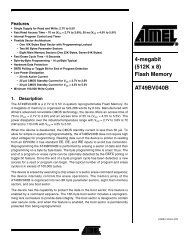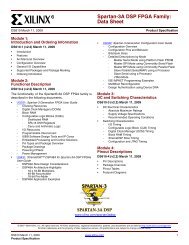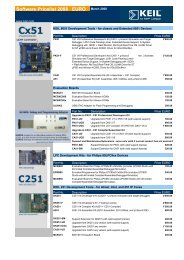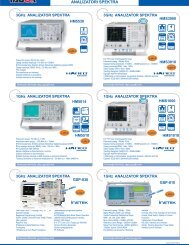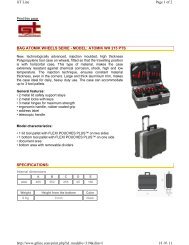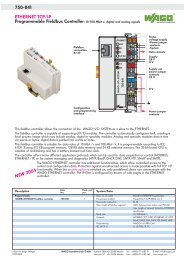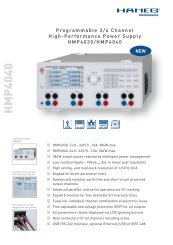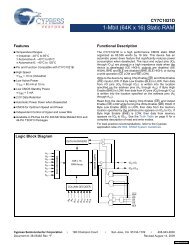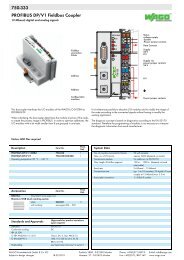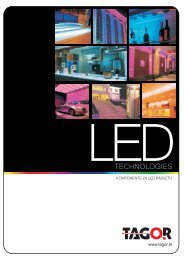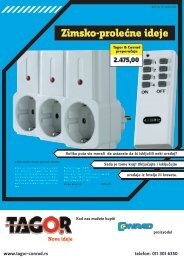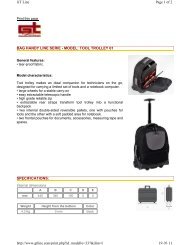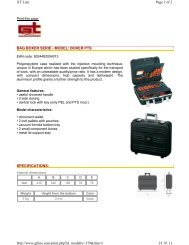PIC12F683 Data Sheet - Microchip
PIC12F683 Data Sheet - Microchip
PIC12F683 Data Sheet - Microchip
Create successful ePaper yourself
Turn your PDF publications into a flip-book with our unique Google optimized e-Paper software.
<strong>PIC12F683</strong><br />
6.2.1 INTERNAL CLOCK SOURCE<br />
When the internal clock source is selected the<br />
TMR1H:TMR1L register pair will increment on multiples<br />
of TCY as determined by the Timer1 prescaler.<br />
6.2.2 EXTERNAL CLOCK SOURCE<br />
When the external clock source is selected, the Timer1<br />
module may work as a timer or a counter.<br />
When counting, Timer1 is incremented on the rising<br />
edge of the external clock input T1CKI. In addition, the<br />
Counter mode clock can be synchronized to the<br />
microcontroller system clock or run asynchronously.<br />
If an external clock oscillator is needed (and the<br />
microcontroller is using the INTOSC without CLKOUT),<br />
Timer1 can use the LP oscillator as a clock source.<br />
Note:<br />
6.3 Timer1 Prescaler<br />
Timer1 has four prescaler options allowing 1, 2, 4 or 8<br />
divisions of the clock input. The T1CKPS bits of the<br />
T1CON register control the prescale counter. The<br />
prescale counter is not directly readable or writable;<br />
however, the prescaler counter is cleared upon a write to<br />
TMR1H or TMR1L.<br />
6.4 Timer1 Oscillator<br />
A low-power 32.768 kHz crystal oscillator is built-in<br />
between pins OSC1 (input) and OSC2 (amplifier<br />
output). The oscillator is enabled by setting the<br />
T1OSCEN control bit of the T1CON register. The<br />
oscillator will continue to run during Sleep.<br />
The Timer1 oscillator is shared with the system LP<br />
oscillator. Thus, Timer1 can use this mode only when<br />
the primary system clock is derived from the internal<br />
oscillator or when in LP oscillator mode. The user must<br />
provide a software time delay to ensure proper oscillator<br />
start-up.<br />
TRISIO bits are set when the Timer1 oscillator is<br />
enabled. GP5 and GP4 bits read as ‘0’ and TRISIO5<br />
and TRISIO4 bits read as ‘1’.<br />
Note:<br />
In Counter mode, a falling edge must be<br />
registered by the counter prior to the first<br />
incrementing rising edge.<br />
The oscillator requires a start-up and<br />
stabilization time before use. Thus,<br />
T1OSCEN should be set and a suitable<br />
delay observed prior to enabling Timer1.<br />
6.5 Timer1 Operation in<br />
Asynchronous Counter Mode<br />
If control bit T1SYNC of the T1CON register is set, the<br />
external clock input is not synchronized. The timer<br />
continues to increment asynchronous to the internal<br />
phase clocks. The timer will continue to run during<br />
Sleep and can generate an interrupt on overflow,<br />
which will wake-up the processor. However, special<br />
precautions in software are needed to read/write the<br />
timer (see Section 6.5.1 “Reading and Writing<br />
Timer1 in Asynchronous Counter Mode”).<br />
Note:<br />
6.5.1 READING AND WRITING TIMER1 IN<br />
ASYNCHRONOUS COUNTER<br />
MODE<br />
Reading TMR1H or TMR1L while the timer is running<br />
from an external asynchronous clock will ensure a valid<br />
read (taken care of in hardware). However, the user<br />
should keep in mind that reading the 16-bit timer in two<br />
8-bit values itself, poses certain problems, since the<br />
timer may overflow between the reads.<br />
For writes, it is recommended that the user simply stop<br />
the timer and write the desired values. A write<br />
contention may occur by writing to the timer registers,<br />
while the register is incrementing. This may produce an<br />
unpredictable value in the TMR1H:TTMR1L register<br />
pair.<br />
6.6 Timer1 Gate<br />
Timer1 gate source is software configurable to be the<br />
T1G pin or the output of the Comparator. This allows the<br />
device to directly time external events using T1G or<br />
analog events using Comparator 2. See the CMCON1<br />
register (Register 8-2) for selecting the Timer1 gate<br />
source. This feature can simplify the software for a<br />
Delta-Sigma A/D converter and many other applications.<br />
For more information on Delta-Sigma A/D converters,<br />
see the <strong>Microchip</strong> web site (www.microchip.com).<br />
Note:<br />
When switching from synchronous to<br />
asynchronous operation, it is possible to<br />
skip an increment. When switching from<br />
asynchronous to synchronous operation,<br />
it is possible to produce a single spurious<br />
increment.<br />
TMR1GE bit of the T1CON register must<br />
be set to use either T1G or COUT as the<br />
Timer1 gate source. See Register 8-2 for<br />
more information on selecting the Timer1<br />
gate source.<br />
Timer1 gate can be inverted using the T1GINV bit of<br />
the T1CON register, whether it originates from the T1G<br />
pin or Comparator 2 output. This configures Timer1 to<br />
measure either the active-high or active-low time<br />
between events.<br />
© 2007 <strong>Microchip</strong> Technology Inc. DS41211D-page 45



